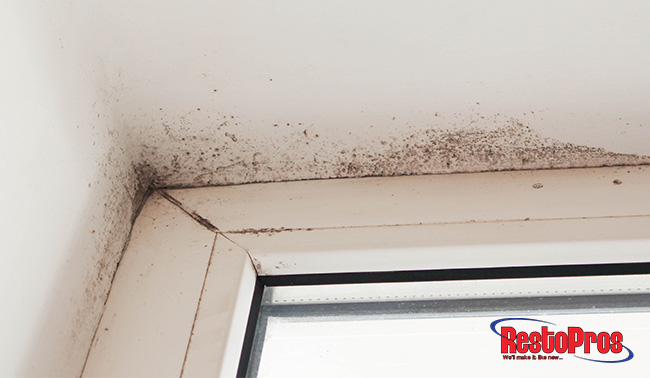The irritation in back of your throat has gotten worse. You also bought some eye drops, because your eyes have been red and itchy lately. It was a wet October here in Dallas this year. You’ve even had some water damage in the house, but it was minor – or so you think. You pull back the corner of the carpet in the bedroom where the leak was the worst and see black colored mold.
Like some vampire from an old movie, you immediately cover your mouth and nose with your arm and run out the room. Does the color of the mold mean you’re in danger? Fortunately for you, the professionals at RestoPros – the leading mold and water remediation company for the greater DFW Metroplex – are going to teach you the differences between common mold and black mold.
-
Molds Defined.
There are several types of mold that are black colored. Some of these molds are toxic and some are not, and not all toxic molds are black. Generally speaking, mold is the visual growth produced by filamentous fungi. Mold is sometimes confused with bacteria, but unlike bacteria, mold is a eukaryote organism with a complex cell structure. Mold serves an important role in the ecological system as a decomposer – and in some cases – mold is responsible for saving more lives than it has taken.
-
Is Black Mold Dangerous?
While black mold can be harmful to humans, its reputation as a deadly killer is somewhat overhyped. In fact, according to the Centers for Disease Control and Prevention, calling black mold toxic isn’t even accurate. Some molds are indeed toxigenic and can produce mycotoxins, but the molds themselves aren’t toxic or poisonous. While black mold is definitely harmful to humans, the simple fact is there are very few links that suggest that toxigenic black mold found inside the home can cause any serious risk to your health. Black mold is mainly a problem for those with underlying medical issues like asthma or a who have a weakened immune system.
-
How Common is Mold?
Mold isn’t just common – it’s ubiquitous. You will never completely rid your home of mold. Mold will happily grow anywhere this is moisture inside of the home, especially in areas like bathrooms, kitchens, and basements where moisture is constant companion. The most common types of mold you’ll find in your home are Cladosporium, Penicillium, Aspergillus, and Alternaria. While Stachybotrys chartarum (black mold) is a less common problem for homeowners, it’s far from rare.
-
What Do I Do If I Find Mold?
While black mold probably isn’t going to kill you, you should take steps to get rid of it. Molds that are on hard surfaces can usually be taken care of with a good cleaning. There are several store-bought cleaners that do a reasonably good job of this, but bleach is still the best method. Mix 1 cup of bleach with 1 gallon of water and pour this mixture into a spray bottle. Molds found on porous materials like drywall, carpet, and ceiling tiles will need to be thrown away.
While we hope this information will give you a better understanding of mold and the risks it creates inside the home, it is no substitute for an experienced professional. The fact is, proper mold removal may be too difficult and dangerous for the average homeowner. The CDC recommends calling a professional mold remediation company in most cases. The mold remediation experts at RestoPros have a long-standing reputation for expertise, professionalism, and hard work. If you’re looking for a skilled and highly trained technician for mold testing, mold remediation, water damage restoration, or HVAC duct cleaning anywhere in the Dallas Metroplex, call us at (855) 58-RESTO (855-587-3786) to schedule your appointment today!

